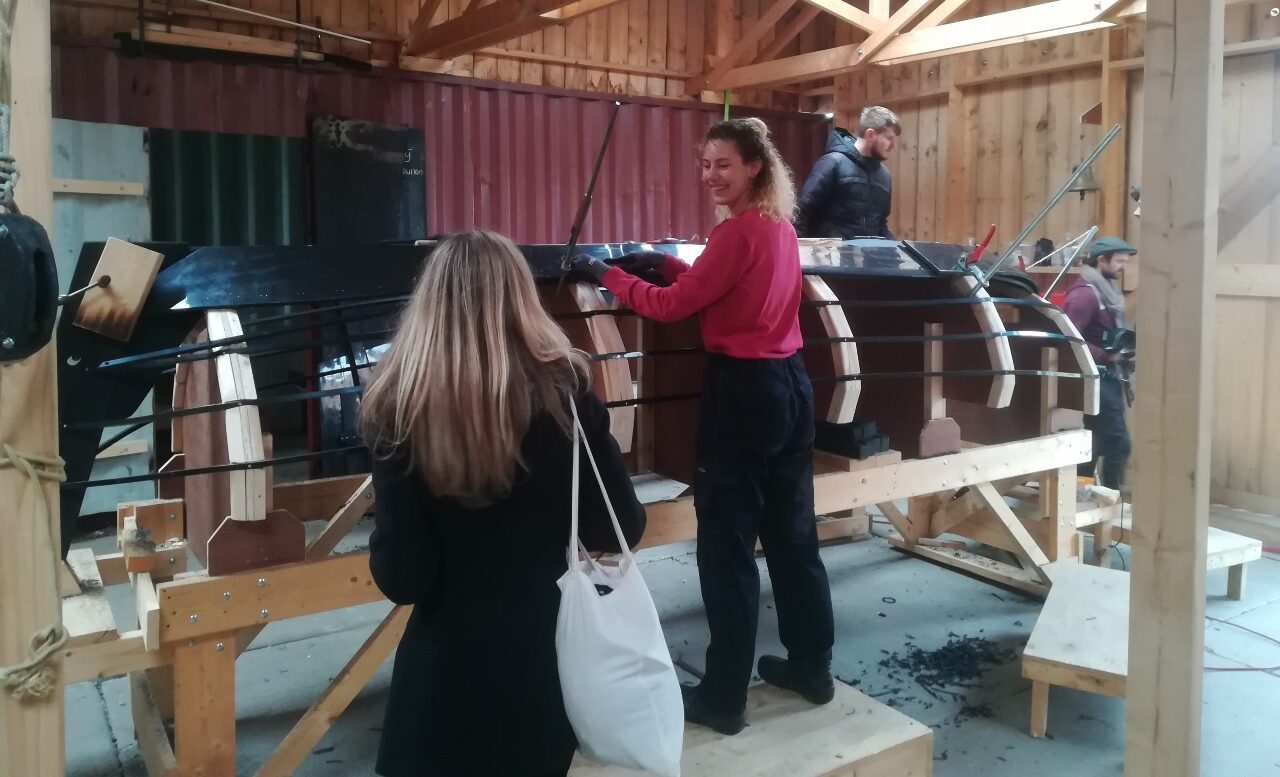We have a new group of boat builders! A mix of ‘old’ and ‘new’ people this time. And behind each group, there is a team of youth coaches. What do they actually do?
We have built three Dutch werkboten, and the fourth boat is almost finished. Built by – in particular – young people with a ‘distance to the labor market’, like some people call them. But we see their potential. They join us through our partner WerkSaam Westfriesland, to bridge the gap between a benefit situation and work or study.
Small boat, great impact, we like to say. Because in this reintegration program, many of these people discover where their qualities lie and what their next step will be towards to work or study. Not by talking, but simply by building a boat together. So far with particularly good results. But how do we achieve those? The key: intensive personal guidance. Kitty Tijhuis, youth coach at WerkSaam and project leader, explains how she and her colleagues do this.
This is where your label can come off
Where many people take it easy at work during summer, Kitty and her colleagues are very busy. To start with a new boat in September, they are composing a new group of 15 to 20 young people. How do they get them excited for a plastic boat?
“We mainly emphasise that here you can do something good for the world and at the same time discover where your talents lie,” Kitty explains. “Of course, not everyone has a thing for boats, but everything is possible here. You can work in the garden, help with social media or come up with your own little project. But the main thing that gets people excited, is that they are allowed to work at their own pace and just be themselves. Many think they have a label: this is where it can come off.”
Do they like it? Then they come by to see the yard and meet each other. If they decide to give it a go, they sign a little ‘contract’. “That’s how we encourage them to commit to this,’ Kitty explains. “Participating is not without responsibility. This makes them express their intention. What we see here, is that they also encourage each other to sign up.”
Not having a job is not the only problem
And then the adventure begins… the young people enter a process in which they start looking for their next step while building up their skills. During this process, they receive intensive on-site guidance from Edwin, but also from the coaches themselves. At least one coach comes by every day to see how things are going.
We wouldn’t be Clean2Anywhere if this youth program didn’t start as an experiment. Because this approach is also new for WerkSaam. The guidance of these young people goes much further than supporting them in finding a job, Kitty explains.
“The fact that some have been on benefits for a long time, says something about their living situation. Not having a job is not the only challenge. Often there are problems with housing, debts, mental or addiction problems, but also an unsafe home situation. The step to work is then simply too big. Placing someone in a job then makes little sense: they’ll be back at your desk in no time.”
In this program, the coaches gain a much broader insight into the situation of these boys and girls. Kitty: “Because we regularly see them, we have a better understanding of which factors hinder them. For one, that’s in working under authority, arriving on time or reversing a day and night rhythm. For another it’s personal care: a good breakfast instead of a bottle of Coke, or ‘just’ showing up showered and fresh.”
Together with their coach, they set development goals and decide what it takes to steer as many areas of their life as possible in the right direction.
“This is a team effort of the coaches”
The daily check-ins at the worksite are new for Kitty and her colleagues. And intensive. “In the initial phase, we have to be on top of it. The first week we get a lot of excuses from the participants: a broken bicycle, overslept, no money for the bus. In those cases we literally come and get you: there is no escape. That’s how we remove barriers. This approach is really a team effort, but it’s paying off.”
Whereas the coaches normally focus mainly on their ‘own youngsters’, here they actually get involved with each other. “We carry this together”, Kitty emphasises. “We speak to each other’s people at the yard and pass on what we hear and see. That way we have a better idea of what’s going on in the lives of the participants and can provide help more quickly if needed.”
Moreover, ‘being there’ gives the coaches much more information to help someone move forward. Kitty calls it ‘windscreen chat’. “When I brought a guy to the yard by car, we got into a conversation about the environment. He said he loved the nature around the yard, something you wouldn’t easily expect because of his rugged appearance. Moreover, at the wharf we see how people behave in a work situation, how they deal with people or materials, what they are good at. You don’t get that kind of information from behind a desk.”
The power of group dynamics
Another important success factor: the strength of the group. After a few weeks, the group dynamic comes into play. “That causes people to start addressing each other; ‘Did they pick you up again this morning?’ Some really take that extra step and hop on their bicycle the next day.”
Another good example is the ‘yard goat’. A girl who did’t have anything with boats but liked animals, suggested a goat to keep up the greenery in the yard. “But who would take care of that goat when she wasn’t there? They needed a schedule and everyone got involved. The goat never came, but they suddenly started talking to each other about responsibility.”
These young people motivate each other. With that said, the coaches deliberately put a few people in the group who they expected to find a job quickly. “They are at the point where the rest are yet to come and have already overcome some struggles. Participation is good for them so they don’t relapse in the meantime, but they are also a good example for others.”
That group dynamic is vital, Kitty says. “Being closed for two weeks for the holidays is too much: the participants quickly lose the connection. So last winter we organized a pub quiz via Zoom with questions about the boats to bring people together anyway. And with the new group we are going to focus even more on active group discussions and activities. This is how we secure that connection.”
They don’t want to leave!
That investment at the beginning pays off on the back end. Within the first four months, 3 of the 15 people found a job and 2 went back to school. The others took productive steps towards work or study. The second trajectory was even more successful.
Kitty: “These young people are much better prepared when they start their next step. They are more thoroughly prepared, know better what they can do and are more self-reliant. The chances of them falling back into welfare are much lower as a result.”
And these are ‘only’ the numbers. Because the young people invite parents and friends to the ship wharf to proudly show the boat they have built themselves. You see the enormous growth in self-confidence and personal development. Some don’t even want to leave here at all! Kitty: “In the first course a guy asked, ‘Can I come more days?’. In all those years, I had never experienced this before.”

